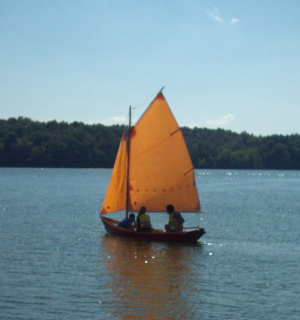
The Great Boat Building Project!
In which four ten to twelve year old girls
and one slightly crazy Dad embark on a journey
that promises to be an education for them all...
 |
|
Weekend
Skiff Splinters on Lake James, NC
|
Goals:
We're a homeschooling family in southeastern Michigan. One of the resources that has helped us is nearby Clonlara School in Ann Arbor. Among many other services, they provide weekly enrichment classes through their School Away From Home program for families like ours that live close enough to visit the campus.
One Thursday in November of 2001, my daughter Alegra and her friend Emily were talking about projects to make for the Imagination Fair, an open house the school holds each winter to showcase projects families are doing with their children. Emily suggested that they could build a boat that little kids could play in and maybe could be turned into a sandbox later.
They began working on their idea, and shared it with another friend, Adrienne. They showed sketches to Adrienne's mom, Elaine, and me. We both wondered if there was a way the girls could build something that they could actually take on the water.
Elaine asked a friend of hers who is an experienced boat builder if he had any ideas. He loaned her a book with plans for a simple skiff, made with plywood, epoxy, and basic tools. She showed it to me, I began to drool, and the rest, as they say, is history.
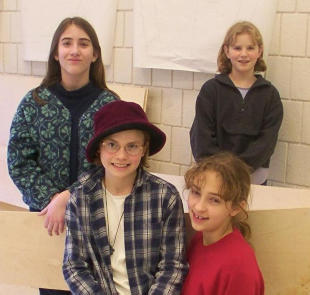 |
The
Fearless Four, (clockwise from top left)
Adrienne, Emily, Alegra, and Rachel. |
|
 |
||
|
"Coach"
Mike and daughter..
|
||
Setting Out
Over the next few weeks I did more research, gathered materials and tools, then launched our small team on its adventure, just before Christmas. Clonlara school generously provided us with space to work in.
We soon learned that there were few things our young ladies couldn't do. With a little guidance they learned to use a variety of tools and the basics of working with wood and epoxy. Together we discovered what it was like to see the shape of a boat emerge beneath our hands.
Our goal was to display the boat, as done as possible, at the Imagination fair in March. Working steadily, putting in at least a couple of days work most weeks, and only a little extra push at the end, we were able to present the complete though unfinished hull, spars, rudder, and dagger board, rigged with a suit of sails a local sail loft made for me. Our skiff, Splinters, was an impressive sight in one corner of the large room, the first thing that drew your eye as you walked in.
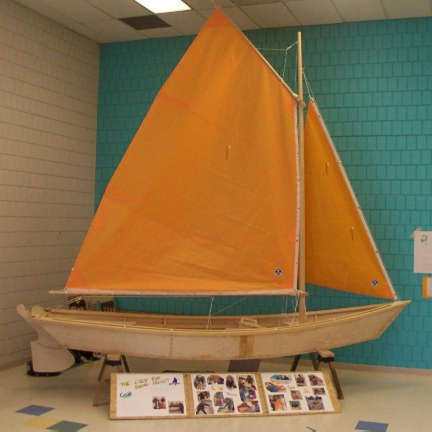 |
|||
 |
|||
| The happy team and their proud coach. | |||
|
Weekend
Skiff Splinters on display at the Imagination Fair, March 2002.
|
|||
It was time for a break, to catch up with the rest of our lives. As it turns out, it was a very long break...
We brought Splinters home on the roof of our car -- an experience that convinced me we needed a trailer! I shopped around for a few weeks and found a used one, that we ended up completely rebuilding to restore it and adapt it to the boat. That took most of the summer. By the time it was done other demands were piling up and I didn't get back to boat building until a full year had gone by, in March of 2003. By then, unhappily, and not surprisingly, we had lost most of our team: Adrienne and Rachel had moved on to other studies and did not want to add another big project back into their schedules, while Emily had moved to North Carolina with her family in the fall.
Phase Two...
So Splinters began a new phase as more of a family project. Once more we set up at the school, and Alegra and I started work, with steady help from her brothers Stephen and Brian, and occasional contributions from other friends and Clonlara students.
We soon had a new goal to work towards, a vacation in North Carolina with Emily's family in mid-May. Could we be ready to launch in time? Well, no... In the next month we finished the last of the carpentry on the inside of the hull and turned the boat over to finish the bottom. Emily rejoined us then for a three week stay before we were to head back south. We managed to fiberglass, fill and paint the hull in that time, but we were still a long way from being able to complete the interior, to say nothing of putting together any kind of rig. So, we left for a well earned and fun vacation in the Blue Ridge Mountains.
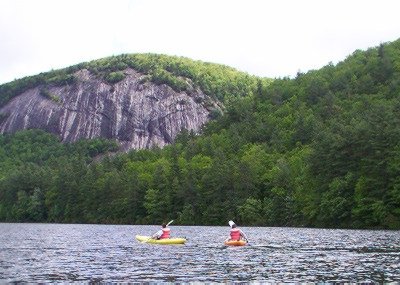 |
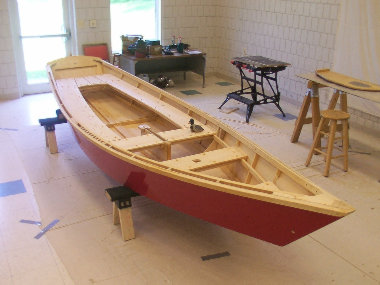 |
||
| June of 2003: Splinters is ready for us to finish off the inside. | |||
|
Reward
for our hard work: A relaxing vacation in the mountains of North Carolina.
|
|||
After a restful week, Emily came back to work with us until Alegra was to go back down with her for another stay. Work resumed and we completed building the big aft seat, did final prep for finishing the interior, and got first coats of epoxy on the inside of the hull and all the seat parts. When Emily and Alegra went south again we packed up all the tools and materials. Then, for the second time we brought Splinters home from Clonlara.
This time all work did not grind to a halt! I bought a 10 x 20 foot tent to work in and set it up in the driveway. We spent the rest of the summer applying epoxy and varnish. It was slow at times, occasionally going a week or two without putting in a day's work. No matter, there were 6 coats of varnish on the inside of the hull by the end of October.
The Home Stretch
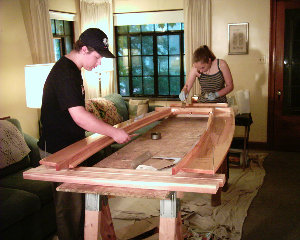 |
|
Seemingly
endless varnishing...
|
Finally we lost the warm weather and the holiday rush set in, and the new year brought more busy-ness. Yet, come March, 2004, we were moving furniture around in our living room to clear space for applying the last coats of varnish to all the seat parts. Seemingly countless varnish, drying, and sanding cycles later, the seats were done and ready to install.
It was the end of May, and we were preparing ourselves for the final push. We made a list of everything we could think of that still needed to be done. Looking back over that task list, I can see that there were only 8 days between June 1st and July 23 that we did not do something on the boat. Most days, there were from 5 to 15 tasks checked off. Alegra, Stephen and I were the main workers, while, by choice, Brian prepared a lot of meals and took up slack for the others' chores. Once again, Emily came up and stayed with us for the last week and a half of building work and to be there for the launch.
The seats were in, the mast and spars were varnished, fittings were bedded and bolted on. Lines were tested with cheap rope and twine, then replaced with good stuff from the marine supply. We learned to whip ends and splice rope. All the final details of the rig were wrung out, safety gear bought, trailer and hull registered with the state, and everything was finally ready.
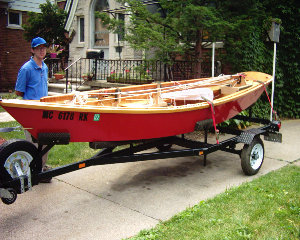 |
|
At
long last, ready to go
|
Sailing!
We launched on Friday afternoon, July 23, 2004, at Stony Creek Metropark, 25 miles north of Detroit. Present were Emily, Alegra, Stephen, Brian, my wife Rosie, and brother Bob. We put her in the water and she floated "on her lines" as they say, and felt stable and good to sit in. Alegra, Emily and I pushed off for our first attempt, the girls sitting in the stern and me rowing..
Conditions were not ideal for a first sail. The wind was stiffer than we'd expected, probably 15 to 20 mph, and after rowing around for almost a half an hour without making any headway I decided discretion was the better part of valor and chose not to try to put up the sail. We ended up beaching the boat safely about 300 yards downwind, and recovered it by bringing the trailer around and carrying her the short distance to the road. Not a perfect beginning, but a success in the end, and certainly educational!
Our second opportunity came Sunday, the 25th, another warm bright day at Stony Creek, but with more moderate winds. We rigged and launched, and the girls and I rowed away from the dock as we had before, except this time Alegra sat in the bow. That changed the balance enough so the boat rowed just fine now and we could easily make progress against the wind if we wanted to.
We set out in the quiet cove by the ramps, where nearby land and trees blocked most of the wind. We rowed for a bit, then raised the mainsail. After ghosting along slowly for several more minutes we finally reached open water and caught the breeze. All of a sudden the hull began burbling along in the water, the wind in the sail heeled us over slightly, and we were sailing!! It seemed as if it all became real at that moment. You could hear our cheers all over the lake.
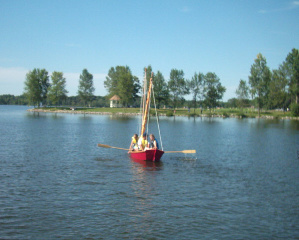 |
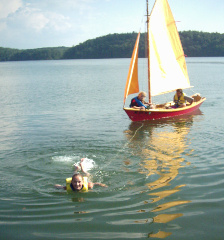 |
||
| Alegra demonstrating one way to handle a dead calm on Lake James. | |||
|
Alegra,
Emily and me, rowing out before our first sail on Stony Creek Lake, July
2004.
|
|||
Since then we've sailed a good number of times, both at Stony Creek, and at Lake James near Marion, North Carolina, close to where Emily lives now. Emily, Alegra, Stephen and Brian have all had enough coaching to be able to handle the helm. I've had the pleasure of standing on shore and watching the kids I've taught, sailing in the boat we've built together.
The rig has proven itself to be amazingly well balanced. She works on every point of sail, goes well to windward, and moves nicely in all but the lightest air. She's comfortably stable in most conditions and quite hard to tip. With a reef in, she's safely handled the stiffest wind we've tried her in. Experience has proven that we could have handled the winds that first day, if we knew then what we do now.
Splinters earns admiring looks and compliments wherever we take her. And we've met an amazing number of people who've built their own boats or otherwise appreciate wooden boats and the traditional looking rig. I never tire of telling people about the kid-built aspect of the project, and the great experiences we've shared along the way.
More about the project...
I've put together this web site so that other familes and prospective boat builders can be inspired by our effort and learn from our experiences and mistakes.
There are lots of things I've learned building Splinters that would save other first-time builders a lot of time and headaches. Also, the errors and successes in my management of the project can help you if you're contemplating a similar effort.
Below are links to the three main sections of the site: The Boat gives information on the plans, the rig, and the performance of the final product. Logbook chronicles our building and sailing experiences. Construction gives a detailed look at how the boat is made, and would be of the most help if you're thinking about building the Weekend Skiff.
Splinters sculling into the dock in the company of
John VanSlembrouck in his Acorn, Lesson One.It's been an adventure! We started with four girls who learned good woodworking skills and built the complete hull of a boat. Then we carried on with two girls and help from the rest of the family and other friends, to finish and rig it. We got valuable guidance along the way from various experts and generous fellow boat builders. Now we have a pretty little skiff that's fun to sail.
The Weekend Skiff is nicely designed. It works well, looks good, and is easy to build if you follow the plans! Of course, we decided to finish the entire insides with varnish, and I took the basic hull and added an elaborate sail plan which has turned out a lot better than I had any right to expect, given my total lack of experience with boat design. So our project took a lot longer to complete than it should have. I imagine Butz & Montague will be amused at what their simple skiff became under my influence!
But the really thrilling part has been seeing the kids learn and grow and rise to new challenges. The girls showed dedication that really impressed me. Frankly, the project dragged on too long, and we lost two of them as a result. Still, I know the experience that they had taught them more than just how to swing a hammer. They pulled together as a team, learned to manage themselves in a large project, and produced something bigger than any of them would have dreamed of on their own.
Later on, Alegra and her brother Stephen carried the project, with me working alongside them. It became more and more a collaboration among the three of us as their skills continued to develop, along with a stubborn determination to see the job through.
Emily, though she now lived 800 miles away, took every opportunity she had to come and help, and was always enthusiastic and hard working. While we were visiting with her family in North Carolina I learned that she has been volunteering for Habitat for Humanity. She did have to convince a few people that, yes, she really did know how to do all this stuff... that she learned it while building this great boat... See, there's even a web page! She's the youngest volunteer on the job site, and they don't let her use any power tools yet (though she certainly could!), but they are as impressed with her skills and attitude as I have been from the very beginning.
Stephen, meanwhile, has been looking at other boat designs and is intrigued by a couple that he's seen. He's considering building, for high-school wood shop credit, a smaller, more simply rigged craft that is light weight and easily car-topped. He vows that it won't take him two and a half years to build, and that there will be very little varnishing to do! And I trust that he'll build a very good boat.
Alegra is our youngest. When you're the baby of the family, leadership seems to default to the older siblings. Now she's had more than just a taste of being first. In fact, she's taken an adult size share of an adult size project and seen it through to success, and it's done a lot for her confidence.
It's hard to point to any particular thing for her, like Stephen's future boat or Emily's work with Habitat, but it's no coincidence that this year she was accepted into a special Girl Scout troop from our region that serves as part of the Governor's Honor Guard at Mackinac Island for a week each summer. This is something of an elite group, and our daughter was as comfortable with her new duties and novel situation as we as parents could ever hope for.
So personal growth ranks near the top of the list of benefits we've enjoyed from building Splinters. It's been that way for me, perhaps even more than it has for the kids. Of course I have had to learn enough about boatbuilding to stay ahead of them. There's a lot to know! But also it has brought us closer together, while at the same time challenging my ability to teach, encourage, inspire and lead.
Not all the lessons we've learned were ones I planned -- like dealing with discouragement and disappointment, coping with burn-out, and how to follow through on a project that's grown bigger than you expected it to. Nope, that's where my inexperience tripped us up. But with the benefit of 20/20 hindsight, I can give you some recommendations that will save you no end of grief if you decide to launch a boatbuilding project for the youths in your life:
- Choose boat plans that will build exactly the boat you want to own, and then follow them to the letter! Don't editorialize until you've got some experience under your belt.
- If you've not built a boat before, understand that it is very different than knocking together a deck or a coffee table. Consult with as many experienced builders as you can, in person, through books and magazines, and online. Prepare yourself.
- Be conservative, even pessimistic in your expectations: Count on everything taking 5 times longer, or more, than you think it should, both because the kids will work slower than you do, and because you simply will not be able to estimate the tasks accurately.
- Expect to use lots of sandpaper. Nothing is a bigger waste of time than attacking a job with too small of a grit. You'll use a lot more 60 and 80 grit than 220 -- and don't hesitate to drop down to 30 grit when you need to! When it starts to get dull, pitch it! Don't skimp on consumables.
- Minimize the use of varnish. Paint looks just beautiful and takes much less time. It's worth using some varnish for its elegance and to give yourselves the experience, but don't over do it!
- If you decide you need a trailer for your boat, buy a new one! You'll be doing enough work to assemble it and customize it to fit your boat without having to grind off rust or replace old wiring or axle bearings.
- You'll probably make better progress scheduling sleep-overs or lock-ins than trying to get people together for single days or evenings. It will help immensely if you can leave your work area set up all the time.
I can also tell you this: Building a boat together with these young people has been an incredible experience. I've learned probably ten times as much as they have, about sailboats and boatbuilding, certainly, and about working with kids. Watching them learn and grow and achieve makes it all worthwhile. It was a lot of work, but a lot of fun too.
Thanks for visiting!
Mike Devour
September, 2004e-Mail me: mdevour@eskimo.com
Acknowledgements
Special Thanks To:
- Richard Butz & John Montague, for creating the Weekend Skiff.
- Zach, Elizabeth, Katrina, Richard, and my sons Stephen & Brian, for help with building.
- My beloved bride, Rosie, for her help, confidence, and generous indulgence.
- All the parents, for their time, energy, and support.
- Pat & Jim Montgomery and the staff of Clonlara school, especially Kathleen Baxter, for trusting in us, giving us a place to work, and for all the encouragement we could want.
- The campus students of Clonlara School, for sharing your school with us and treating us and our project with care and respect.
- Marco's Pizza for many tasty subs and pizzas at all hours of the day and night.
Thanks for technical assistance from:
- Jerry Rose, for helping me understand the method and practices of boatbuilding.
- Hani Sarafa of Public Lumber Co., Detroit. Yes, Hani, Sitka spruce makes a beautiful mast!
- Jerry Livingston & Darlene Jamroz of Eastpointe Fiberglass Sales, Eastpointe.
- Wally Cross of North Sails, St. Clair Shores. Someone who appreciates the poetry of what we're doing.
- Warren Jones of Thomas' Marine Hardware, Grosse Pointe Farms.
- The many kind and generous denizens of the WoodenBoat Forum whose guidance saved me from no end of errors and whose suggestions refined the rigging plan to near perfection before a line was ever run.